Making a wooden floor in a private house or city apartment is quite difficult, but quite doable. To achieve a high-quality result when working on your own, you should familiarize yourself with the varieties and properties of wood, the rules for choosing a material and its installation.
The main aspects of choosing wood for floors
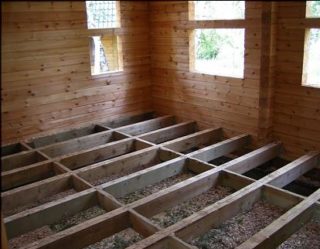
When deciding to build a wooden floor from a board with your own hands, you need to initially decide on the choice of material. This issue must be approached carefully, competently and thoughtfully. Correcting errors can be extremely difficult and sometimes impossible.
When planning a construction, the following criteria should be assessed:
- Wood grade. The first step is to determine the grade for the finish. If there will be no carpet or linoleum on it, it is better to choose the highest grade without knots and chips. The surface should be smooth, clean, polished to a glossy shine.
- The hardness of the material. High-quality boards do not bend or buckle under the influence of solid objects. During operation, the flooring will be exposed to such influences as installing furniture, falling objects with sharp corners, walking in shoes with narrow heels. All this should not leave even small traces.
- Color. The wood's own color is pleasing to the eye and does not need perfection. But different varieties differ significantly in shades. They are light, medium and dark. You need to think about this issue in advance. Subsequent painting is not the best way out if the surface will not be liked by someone.
- Thickness. It should be sufficient to exclude the slightest likelihood of deflection under cabinet or upholstered furniture, the most difficult person living in an apartment. Experts recommend using products with a thickness of 25-30 mm.
- Length and width. It is advisable to choose boards, the size of which is not less than that of the room where they will be laid. The optimal width is 100-125 mm. It is not worth taking more widely, as they can bend.
- Humidity. The wood must be well dried, as wet boards will lead and gaps will appear between them. The optimal level for the finishing floor is 12%, and for the rough floor - 17%. If there is no longer a choice and you have to buy freshly sawn material, you need to bring it up to condition yourself.
- Stock. No one is immune from mistakes. You should have a reserve of 10-15% of boards and beams. Even if lumber does not go into business, you can make furniture for various purposes from it - a table, shelves, stools, a bench.
The last aspect to consider is cost. It is recommended to choose the most expensive and high-quality material that will last no less than the building itself.
Scope of wood floors
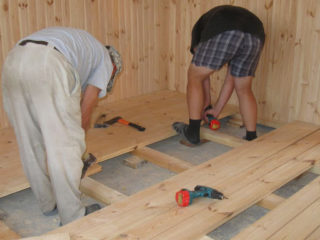
Wood flooring is widely practiced in both private and commercial construction. The material attracts with its versatility and variability.
The scope of its application extends to the following objects:
- living rooms;
- kitchens;
- loggias and balconies;
- country houses;
- private houses;
- gazebos, terraces and verandas;
- recreation rooms and steam rooms in saunas;
- decks and cabins on watercraft;
- offices and small retail outlets;
- fitness clubs, gyms, beauty salons.
Planks or parquet floors can be laid almost everywhere where there is no traffic. Even the influence of such a factor as precipitation can be reduced to almost zero if modern effective impregnations, varnishes and paints are used.
Advantages and disadvantages
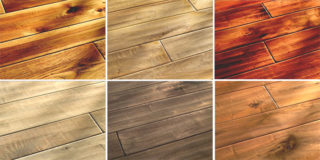
Wood flooring has given way to laminate and self-leveling surfaces, but still occupies a leading position. This is justified by the following advantages:
- Environmental friendliness and safety. Natural material remains neutral in all conditions, and even with a slight heating it emits a pleasant characteristic odor.
- Creation and maintenance of a comfortable and healthy microclimate in the room. With an excess of moisture, the tree absorbs it, and with a lack of moisture, it gives it away. This is accompanied by a slight change in the volume of the material, but does not affect the appearance of the structure.
- Low thermal conductivity. A well-dried material retains heat and cold. It does not need additional insulation, which has a positive effect on the construction budget.
- Ease of processing. Wood can be easily processed with hand and power tools. It effortlessly includes nails, staples and screws.
- Maintainability. Chips and dents can be easily repaired with a special putty or mastic. Replacing a damaged floorboard does not cause problems.
- Pleasant sensations upon contact. Regardless of the ambient temperature, the coating always retains tactile warmth. You can walk barefoot and even lie on it without the risk of getting sick.
- Ease of cleaning. Provided proper preparation is carried out before installation, the material does not absorb water. Contaminants such as paint and varnish can be removed from it without any problems. The wood is resistant to all types of solvents.
- Sufficient strength. The boards can withstand high permanent and shock loads without damage. Elasticity allows them to maintain integrity when exposed to strong impacts.
- Long service life. Provided that the rules for the installation of wooden floors and their maintenance are observed, their service life will be decades.
- Presentable appearance. The floor made of natural material organically blends into the interior and shapes its style. The coating creates a feeling of comfort and coziness.
Ideal material does not exist, each has its own negative sides. This must be borne in mind when planning the installation of a wooden floor.
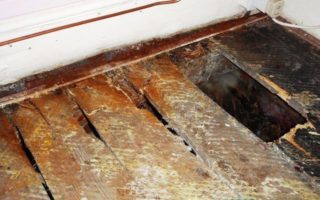
Disadvantages of this design:
- Quite high cost. It is formed from the price of the enterprise license, the services of lumberjacks, drivers, sawmill workers, drivers and administrative personnel. Plus amortization of areas for the period of forest drying.
- Abrasion. This property is characteristic of all organic substances. This becomes especially noticeable after a few years in places with high traffic. The way out is to replace boards or putty.
- Attractiveness to insects and pathogens. Under their influence, the tree becomes rotten, rots, loses its strength and elasticity, and completely collapses quite quickly.
- Hygroscopicity. Even after processing, the boards still absorb moisture. This leads to swelling, subsequent drying, stains and cracks.
- Softness. This quality is especially inherent in conifers (spruce and pine). Even with not very strong pressure on the surface, dents remain.
- Flammability. The cause of fire can be a cigarette butt, a heater, or a short circuit. When burning, wood gives off pungent and suffocating smoke that is life-threatening. Fire retardants only partially solve the problem.
When deciding in favor of a solid board flooring, you need to carefully assess all the pros and cons of this design, and take into account the operating conditions.
DIY styling instructions
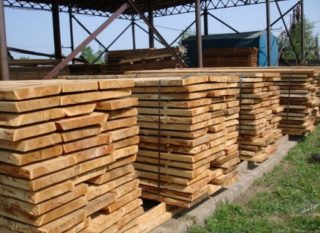
The floor in a private house with your own hands is done in several stages. Each of them needs to be given attention and time so that the finished structure has a beautiful appearance and high performance.
Material preparation
You cannot stack lumber immediately after purchase. Follow these steps:
- Carry out drying, as the forest is rarely sold with the required moisture content. To do this, you need to lay it on a flat surface, laying it with bars for ventilation.
- Level the surfaces with a belt sander, hand or electric planer.
- Treat the timber and boards in accordance with the user's manual, first with an antiseptic, then with a fire retardant and hydrophobic impregnation. After each solution, the raw material must dry completely.
- Place a waterproofing layer on the concrete to protect the wood from moisture.
Finally, you need to sort the material according to its intended purpose, if necessary, mark it.
Making the base for the flooring

When installing on a concrete foundation and a floor slab, a system consisting of support beams and a log is used. It is a time-tested design that is durable and well ventilated.
Installation is carried out in this order:
- Erection of intermediate posts if the size of the runs exceeds three meters. They can be made from bricks or cast from concrete.
- Cleaning the base from dust, dirt and crumbs, laying waterproofing material. Roofing material or several layers of dense cellophane is used.
- Beam laying. A bar of 200x150 or 200x100 mm is selected. Docking of fragments is carried out in an overlay or using the thorn-groove method.
- Installing lag. The step between the timber is determined by the thickness of the boards used. For a product with a thickness of 50 cm, the interval is 100 cm and then is proportional to 5 cm of thickness to 10 cm of the interval. Alignment is carried out using bars, and fastening with nails, screws or corners. If it is necessary to connect two beams, this is done only on an intermediate post and with an overlap of 40-50 cm. It is better to do the joining with pins in order to exclude the likelihood of its divergence.
A vapor barrier film or substrate is installed on top of the frame. It is recommended to use polyethylene foam with good sound absorption.
Laying the finished floor
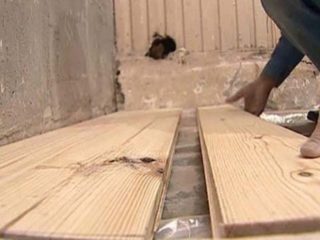
The direction of the boards is determined initially perpendicular to the logs. The connection can be in a joint with a gap of 1 mm, according to the tenon-groove scheme or using an insert-insert for products with side grooves.
Floor assembly rules:
- Laying is carried out so that a clearance of 10-15 mm remains from the flooring to the walls. It is closed with an insulation tape and then a plinth.
- For fasteners, nails or self-tapping screws with a length of 70-100 mm are used. The caps are recessed by 1-2 mm, and the indentations are rubbed with putty.
- For tight joining of boards with grooves, a mallet with a clamp is used. The seam is coated with glue or mastic.
- The connection of the last board is carried out using wedges, which are subsequently removed.
- After installation, finishing scraping is carried out. It will remove the irregularities that remain between the surfaces of the masonry fragments.
The final step is the processing of the wooden floor. It can be covered with stain, wax, oil, mastic, paint or varnish. The choice depends on the type of wood, the style of the premises and the priority of its owners.
Consequences of incorrect installation

When laying a solid wood floor, inexperienced builders can make mistakes regarding the choice of material, its preparation and installation. Their consequences may not appear immediately, but sooner or later they will come.
When using raw wood, the boards lead and wide gaps appear between them. Ignoring pretreatment leads to rot, mold and mildew. If you do not leave the damper joint against the walls, the slats will lengthen and move in waves as the humidity rises.
If the master does not carry out the finishing, the surface quickly gets dirty, abraded, takes on an untidy appearance, becomes vulnerable to mechanical damage, moisture and pathogenic microorganisms.








